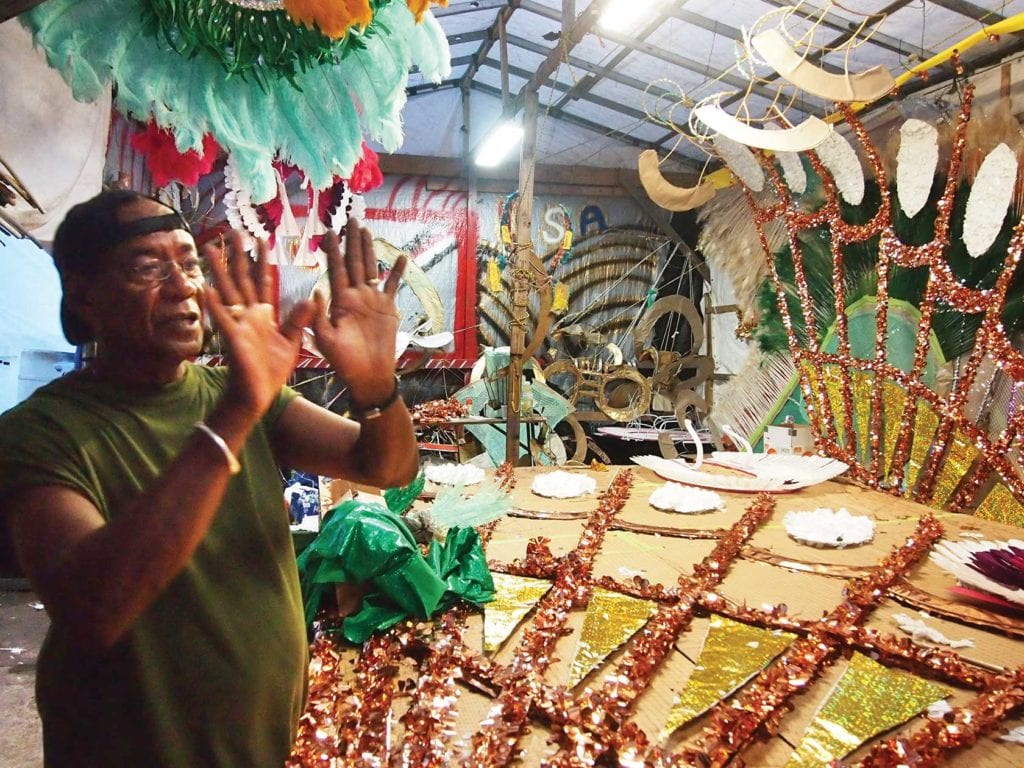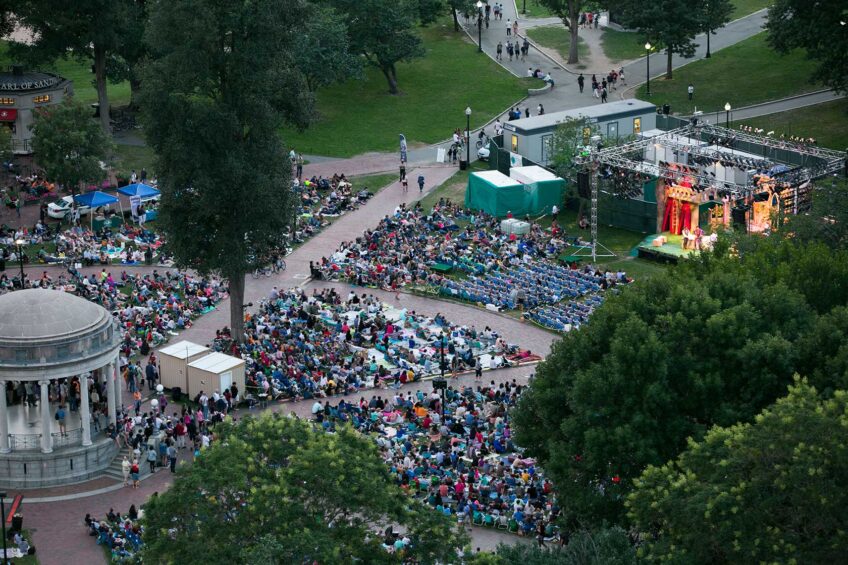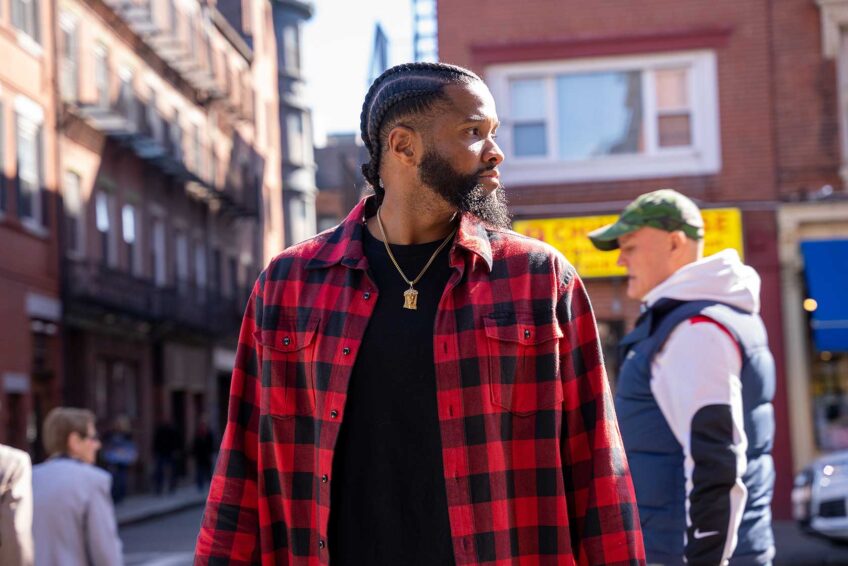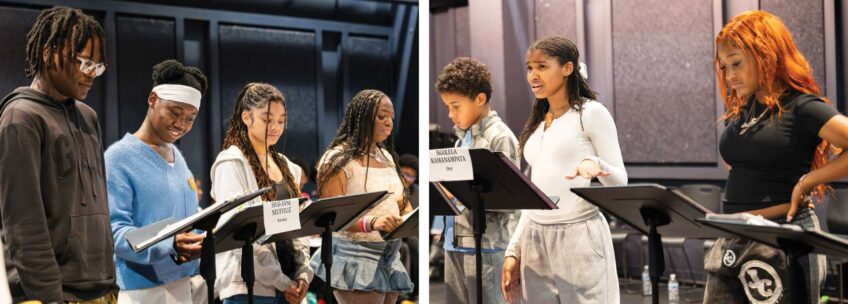The magic behind Boston’s Caribbean Carnival costumes
Soca & Associates prepare for Carnival, designing costumes around an abstract theme.

With scarcely a month before Caribbean Carnival, members of the Soca & Associates masquerade band are busily attending to the construction of their costumes. Master costume builder Ronald “Barney” Blaize is working on the largest — a 30-foot high by 20-foot wide costume for the Soca & Associates queen.

A costume from the “Mysterious Whine” section. Banner Photo
For now, it’s a mass of wire, fiberglass and netting being assembled in the front and rear yards of the Dorchester triple decker at 120 Mt. Ida Rd. that has for decades served as the Soca & Associates mas’ camp, a place where masquerade bands assemble costumes in the months before Caribbean Carnival.
When it’s finished, what will it look like?
Blaize points to a pen-and-ink drawing of a butterfly-like winged creature. Asked whether it’s indeed a butterfly, Blaize gives an answer that gets at the heart of the Carnival aesthetic.
“The thing is about it, it’s in your mind,” Blaize says. “It’s a subliminal message. It creates interest. When you see a costume, it relates to so many things.”
Finished in gold, white and copper tones and replete with metallic foil scales, feathers and sequins, the costume will be worn by the band’s queen with a harness that fits over her shoulders, and the bulk of its heft being borne by a set of wheels behind. The mass of colors, shapes and textures should function as a three-dimensional Carnival-themed Rorschach test for spectators, and more importantly, for the panel of judges who Blaize hopes will give the band a first-place finish in the King and Queen competition, usually held in the week before Carnival.
“It’s bold, it’s unique,” Blaize says. “In the sun it will shine.”
Carnival costume designers often rely on familiar themes — Greco-Roman designs, Indigenous American themes, Egyptian and African-inspired costumes and themes from the insect and animal kingdoms. For this year’s design, Soca & Associates band leader Margaret Black started with a more abstract theme: “Cravings.”
Asked how she comes up with the ideas for the costumes, all of which she herself designs, Black is blunt.
“To be honest with you, I don’t even know,” she says. “Basically, it’s whatever we come up with.”
Sitting in a folding chair in the middle of the mas’ camp, Black cradles a rum-and-coke in a plastic cup, occasionally giving directives to one of the two dozen or so volunteers assembling costumes. Most of the work happens under an 18-foot high enclosure in the back yard, its wood and steel frame covered with plastic sheeting to keep the rain off the costumes.
This year, the band’s seven sections of “Cravings” include the themes “Hidden Lust,” “Bitter Rebel,” “Burning Desire,” “Chocolate Beauty” and “Glitter Envy.” Each section has its own color palate: Fuschia, purple and plum for “Luxurious Whine,” green for “Glitter Envy” and browns and reds for “Chocolate Beauty.”
For Ashlee Perry, a Boston-born leasing agent who lives and works in Southborough and drives an hour every evening to work on the costumes, the band’s theme “Craving” is about Carnival itself.
“It’s about the excitement, the glitz and the glamour,” she says. “We crave to get on the road and whine. We’re craving for more soca, more mas’, more carnival. It’s whatever you make of it.”
Blaize adds, “It’s whatever makes you say “Wow.’”

A costume from the “Mysterious Whine” section. Banner Photo
Perry, who is of Cape Verdean ancestry, grew up watching mas’ players in the Boston Caribbean Carnival and began playing mas’ herself as a teenager. She, like many other mas’ players, says she pines for Carnival season. Besides Boston, Soca & Associates will play mas’ this year in carnivals in Worcester, Cambridge, New York and, for the first time, Miami. For each location, the band will truck the large costumes to the staging area, get assembled and compete with other bands, many of which are affiliates of larger bands in Trinidad and Tobago.
Soca & Associates is Boston-based, operating solely out of the yard around Black’s triple-decker and her basement, which has been transformed into an indoor mas’ camp with the concrete floor painted in the bright red of the Trinidadian flag and mannequins modeling the outfits for each section.
Sitting at a table in the back of the basement, Kwesi Matthew is carefully gluing rows of feathers to a head piece. On his cellphone, he plays a recording of the band’s theme song, “Craving,” which he wrote for this year’s carnival presentation.
“We waiting,” he sings along to the soca beat.
“We cravin’”
“For de fun,”
“For de rum.”

Kwesi Matthew attaches feathers to a headpiece. Banner Photo
That song, which Matthew plans to release to local DJs this week, will compete in Boston with “Wine and Fling It Up,” the soca anthem that was the official song of Trinidad’s February 2018 Carnival.
Black takes in the scene from her folding chair as the volunteer workforce deploys glue guns and fits costumes for a pair of women signing up to play mas’ with the band. Meanwhile, she attends to the business of preparing for the estimated 400 people who will dance in costume or in band T-shirts behind the Soca & Associates sound truck — an 18-wheeler pulling a flatbed outfitted with a wall of loudspeakers and a DJ.
Black, who took over the band from her mother-in-law three years after it was founded, says it’s a lot of hard work keeping the band going. They held a pre-launch in November last year, displaying costumes for this year’s mas. Blaize flew in from Trinidad earlier this summer to work on the larger pieces. Now there’s less than a month to finish everything before Boston’s Caribbean Carnival Saturday, Aug. 25.
For Black, it’s a labor of love.
“I just love the culture, the costumes, the people, the looks,” she says. “I just love everything about it.”
GLOSSARY OF TERMS
Mas’: Short for masquerade. Refers to those who
wear costumes in Carnival.
Mas’ camp: A site, usually the back yard and basement
of a home, used for designing and assembling
costumes and as a gathering spot for mas’ players.
Whine (or wine): A Trinidadian version of the word
wind (as in winding a clock), which describes gyrations
of the waist, hips and buttocks.
Soca: A music style indigenous to Trinidad and
Tobago that includes elements of calypso, U.S. soul
and funk and reggae.







